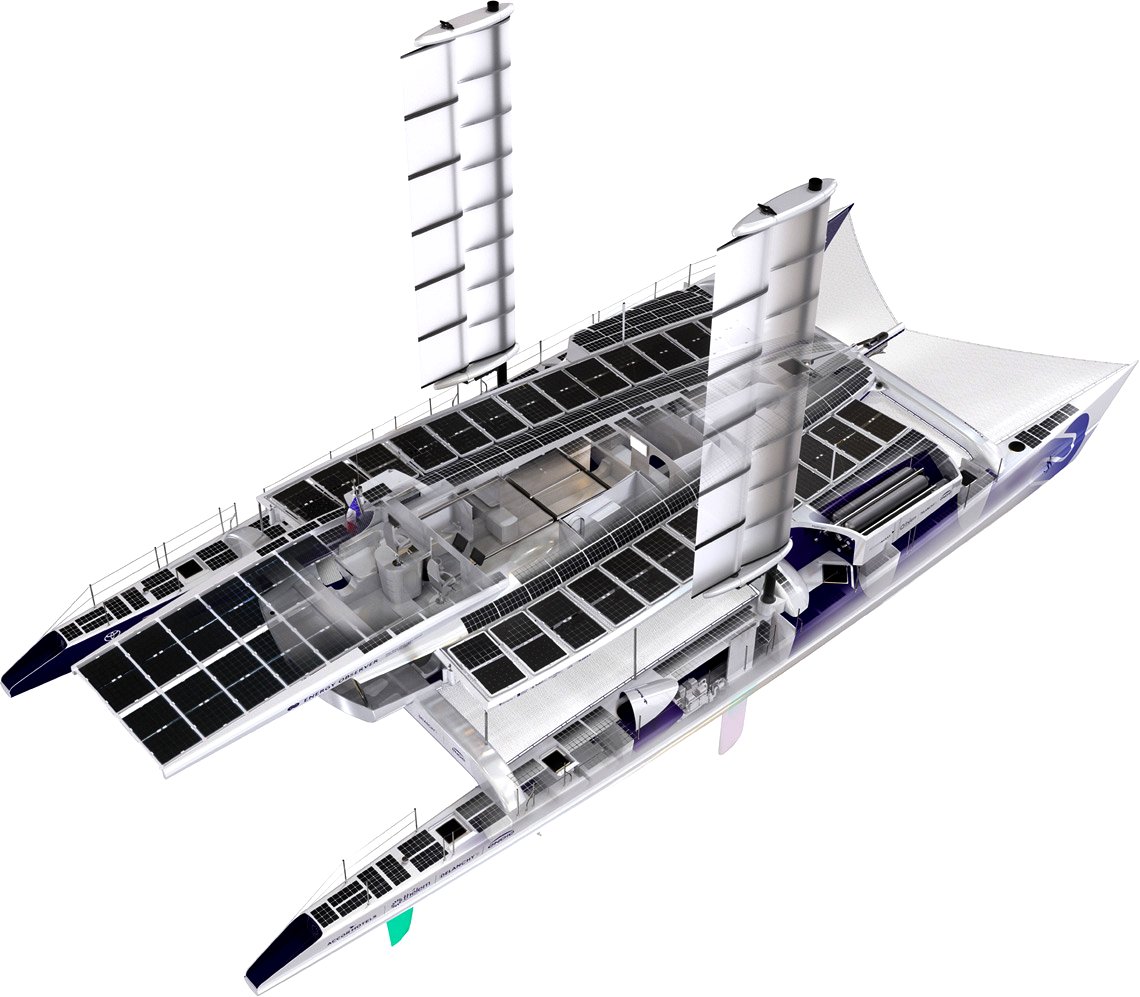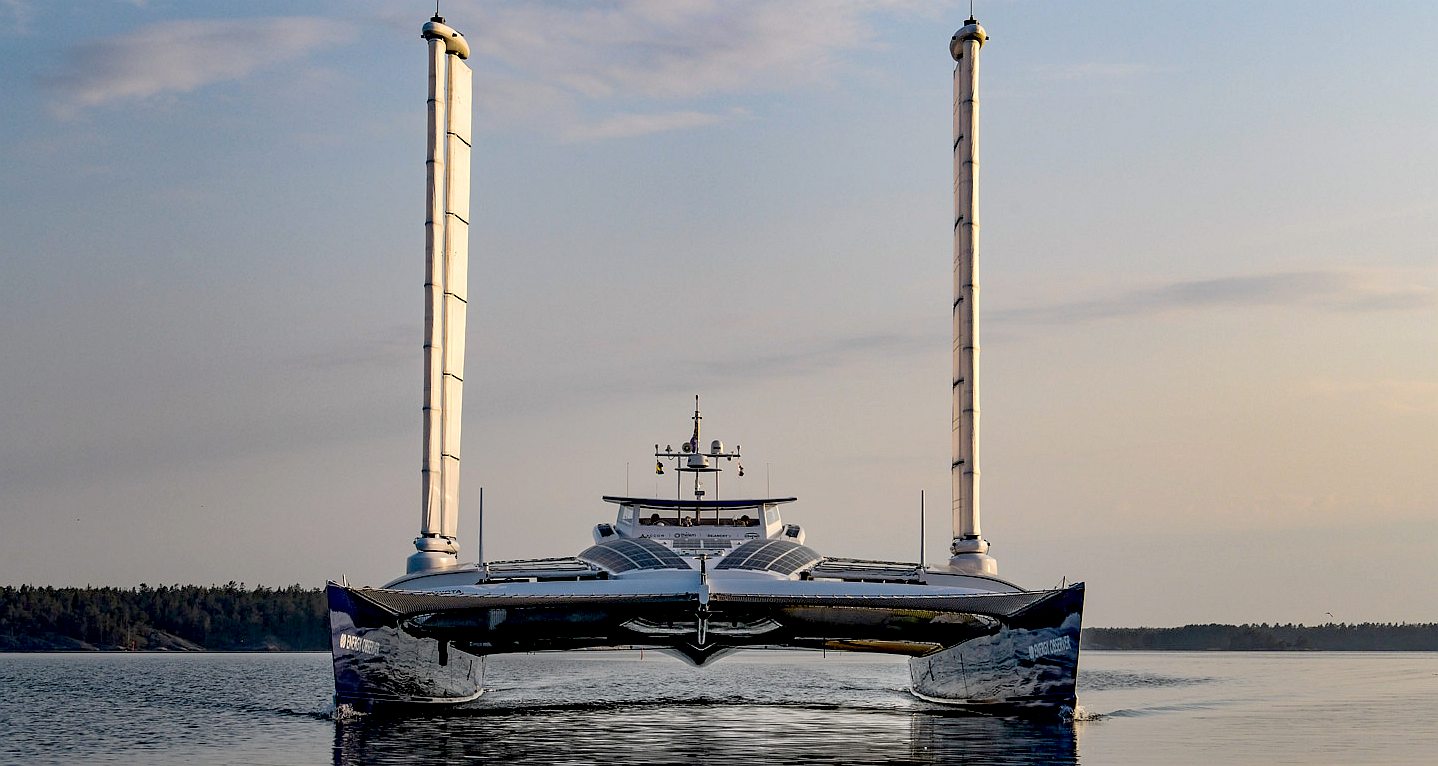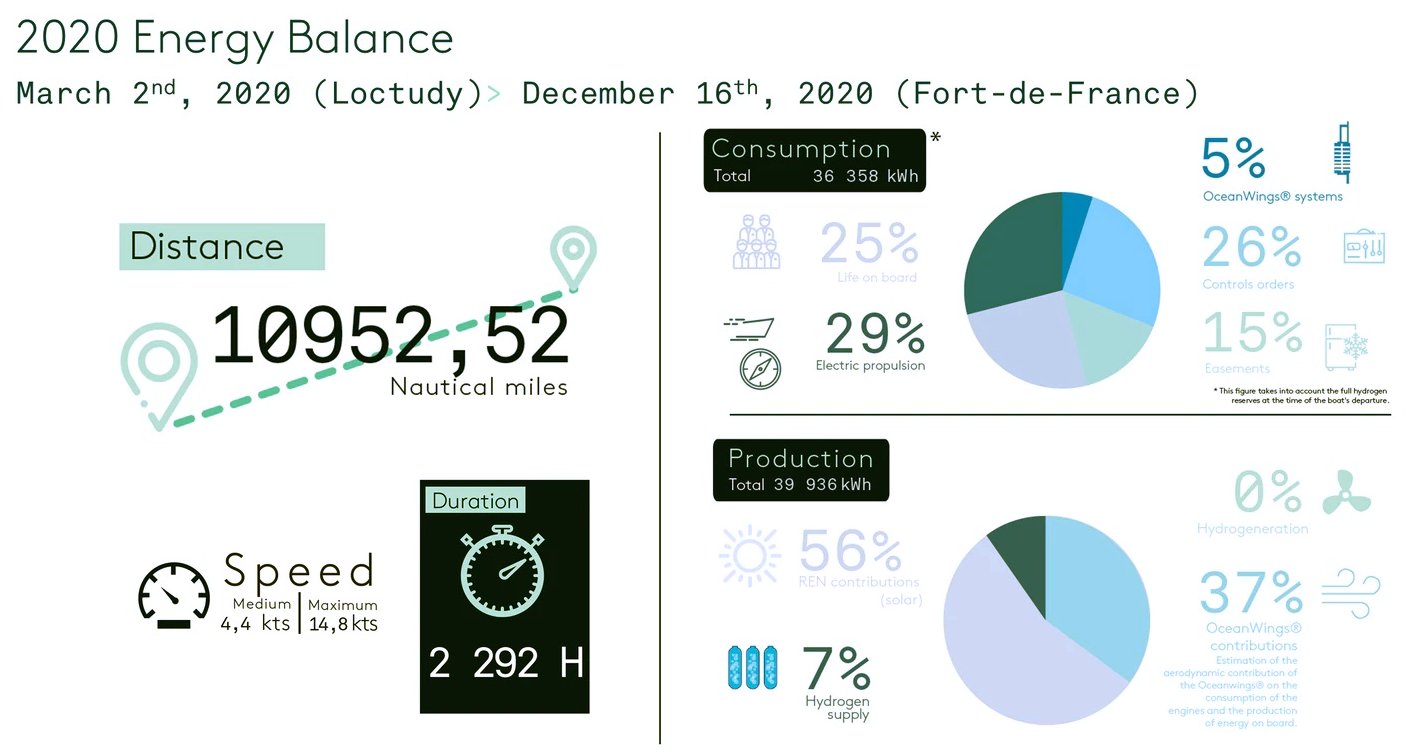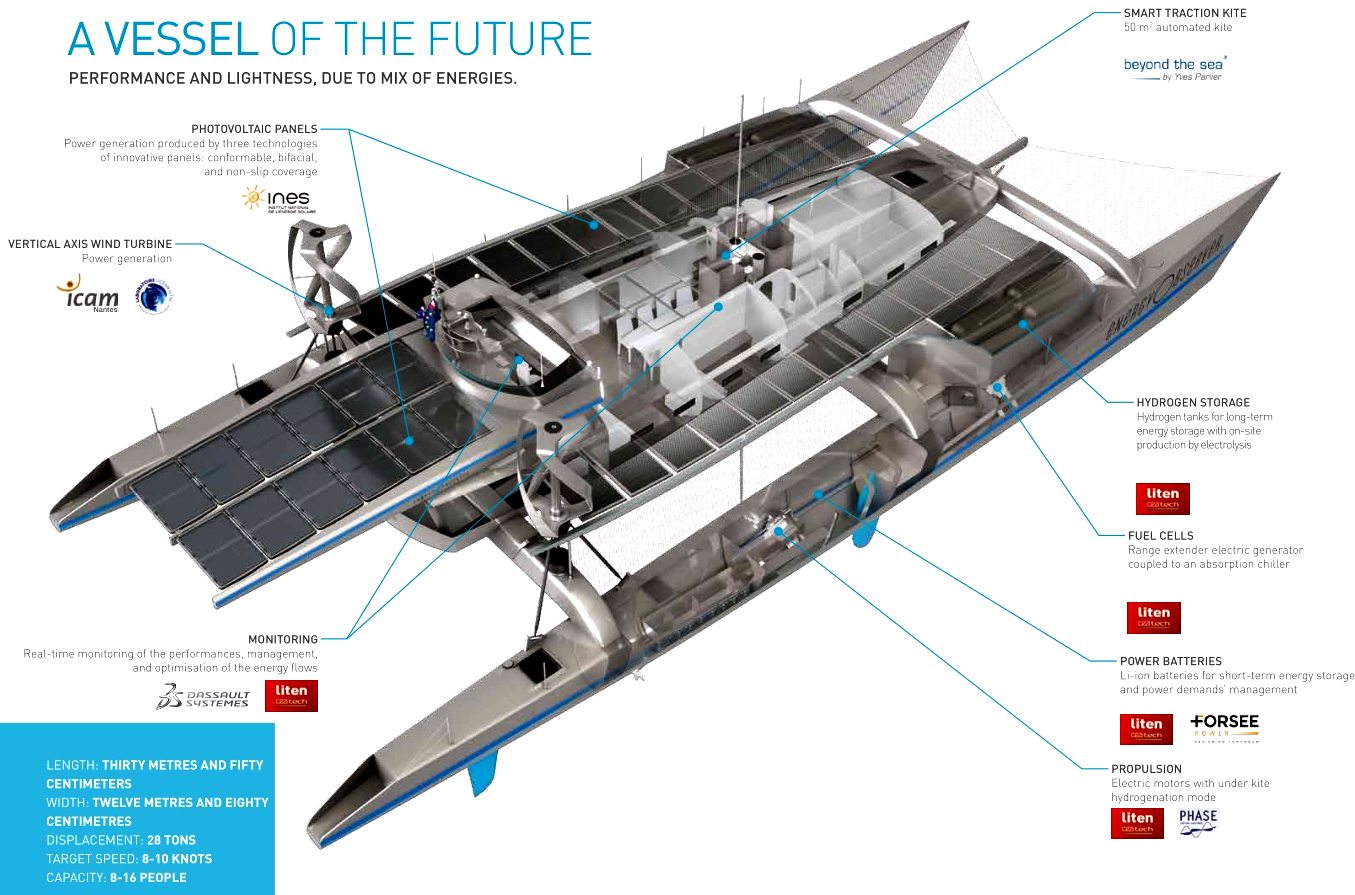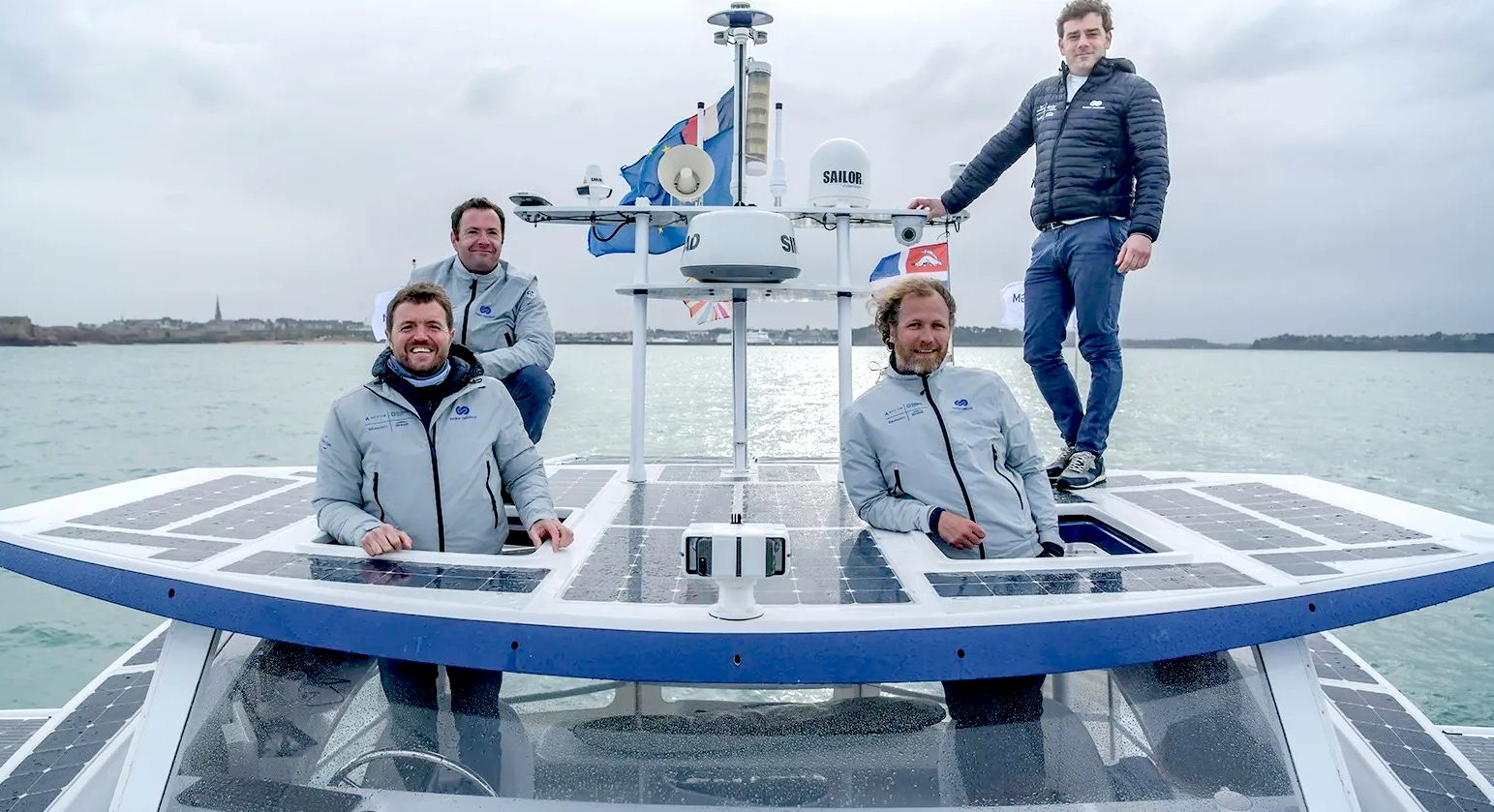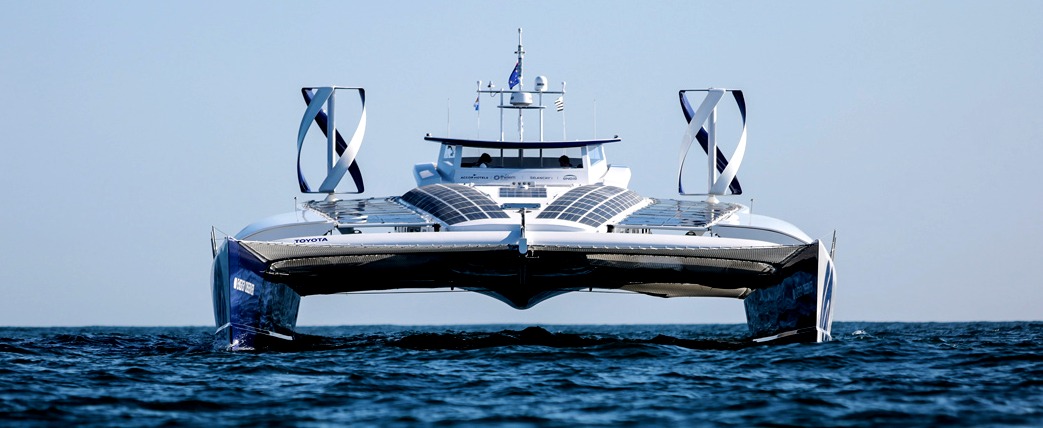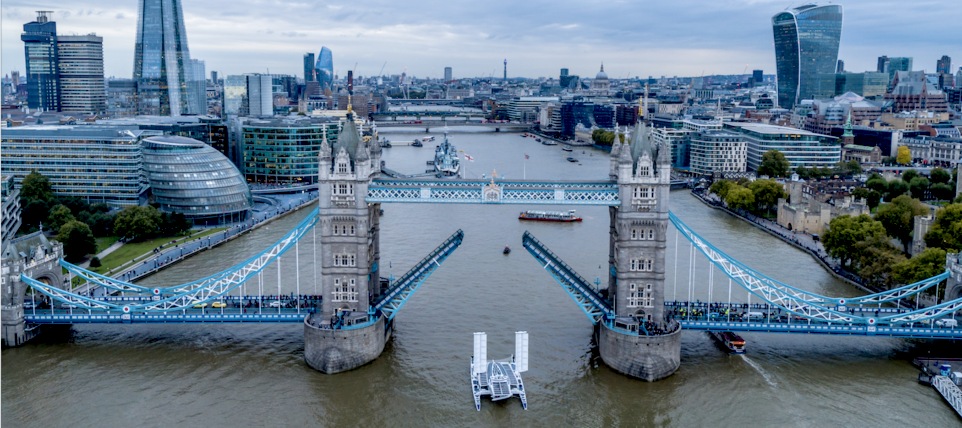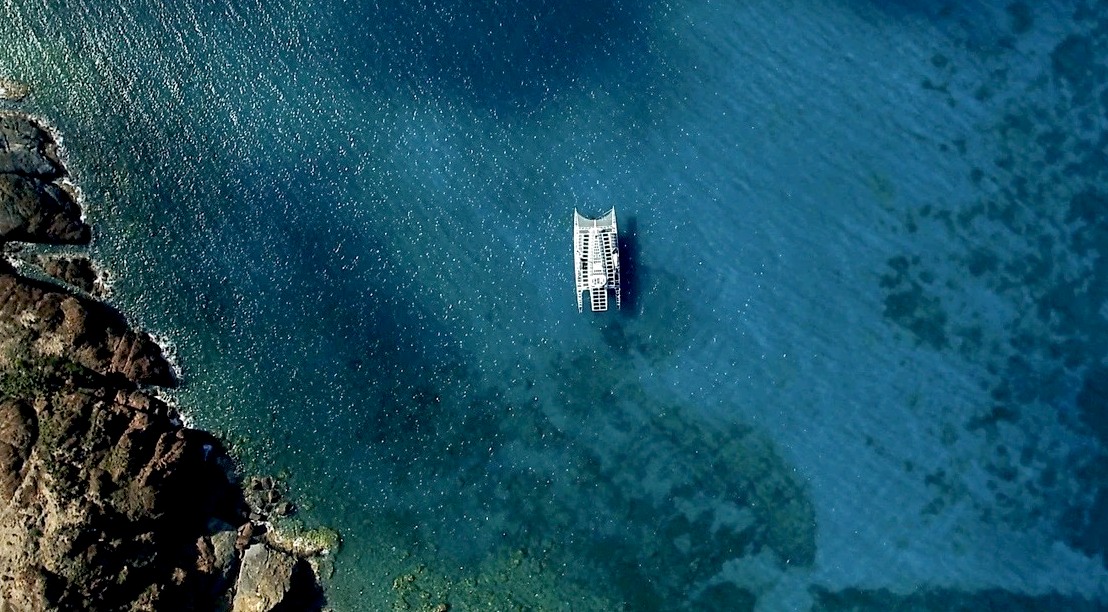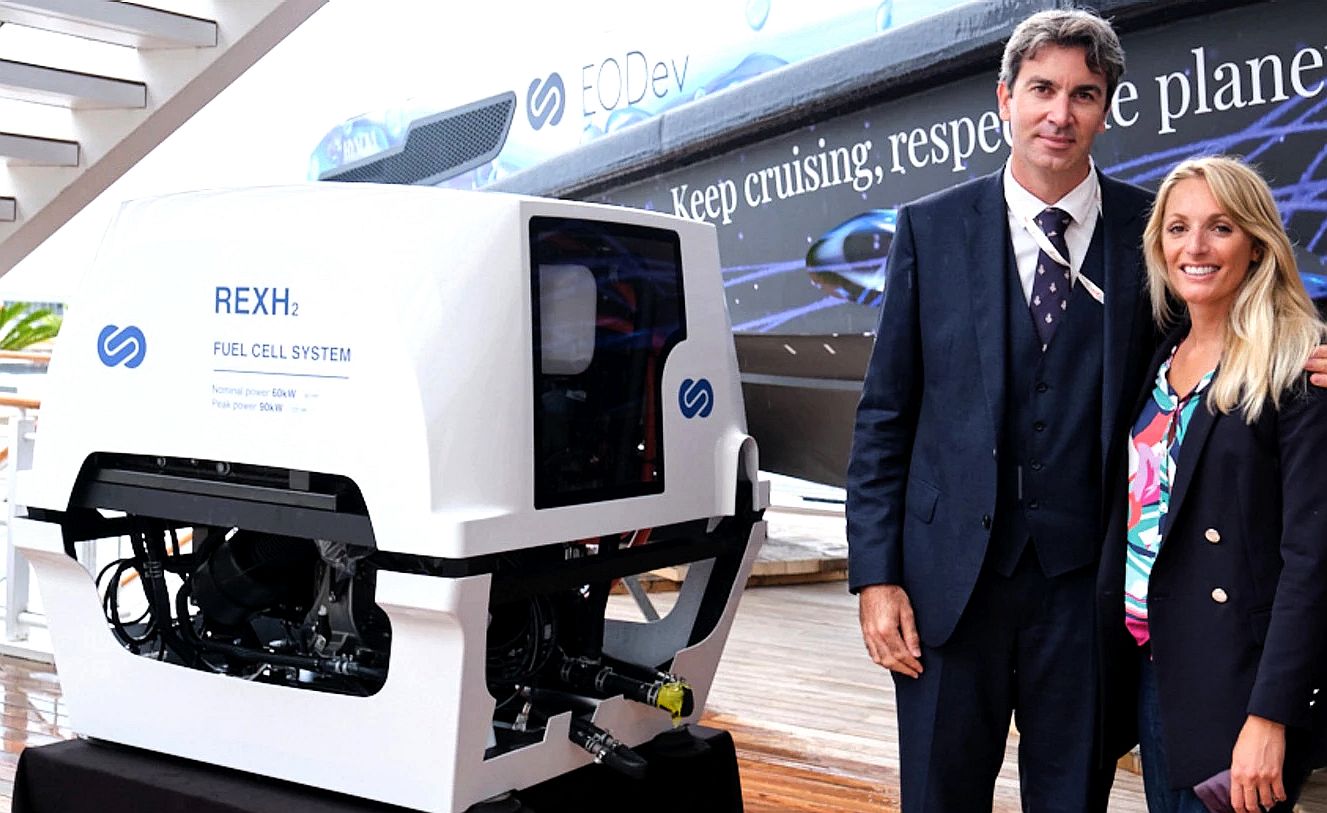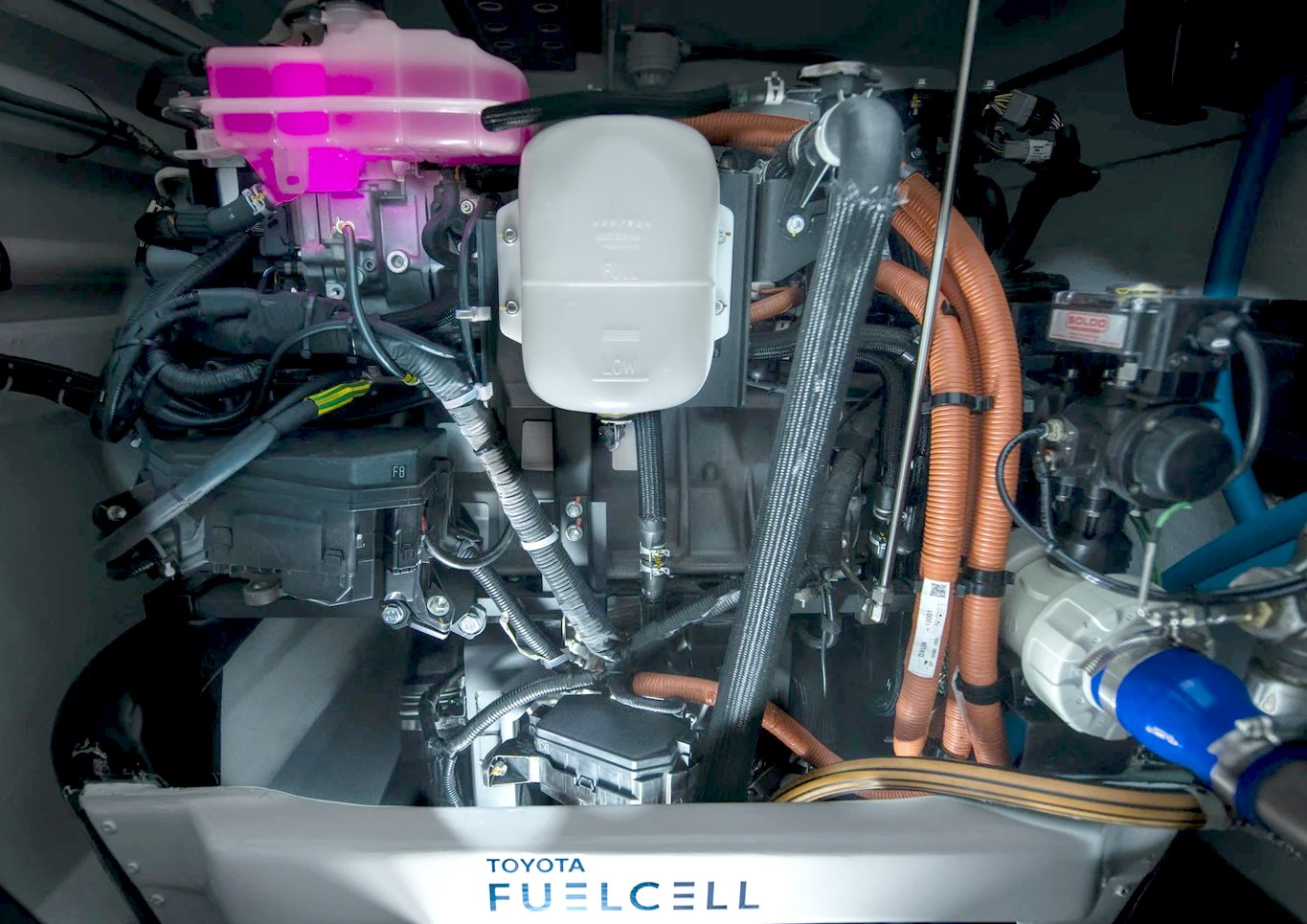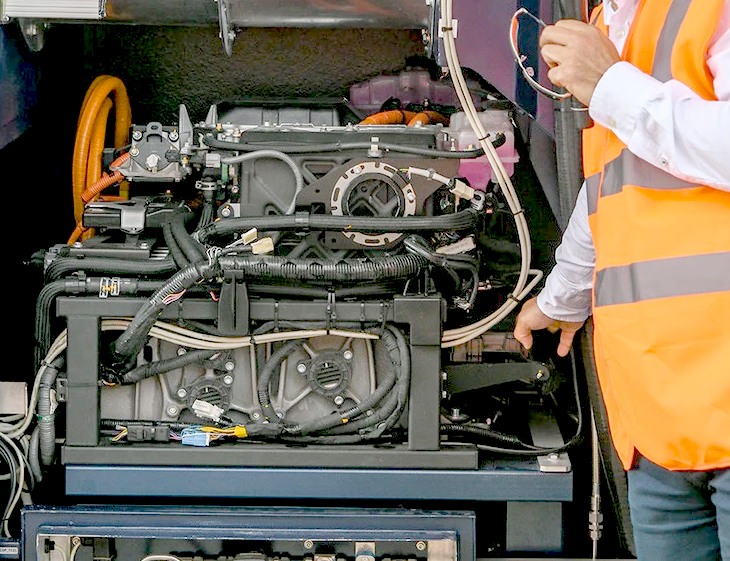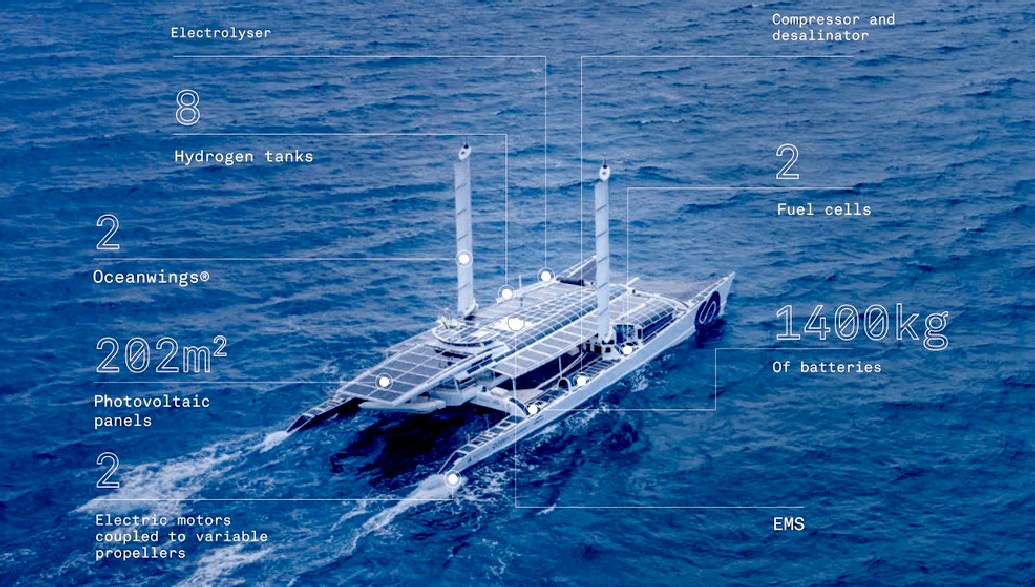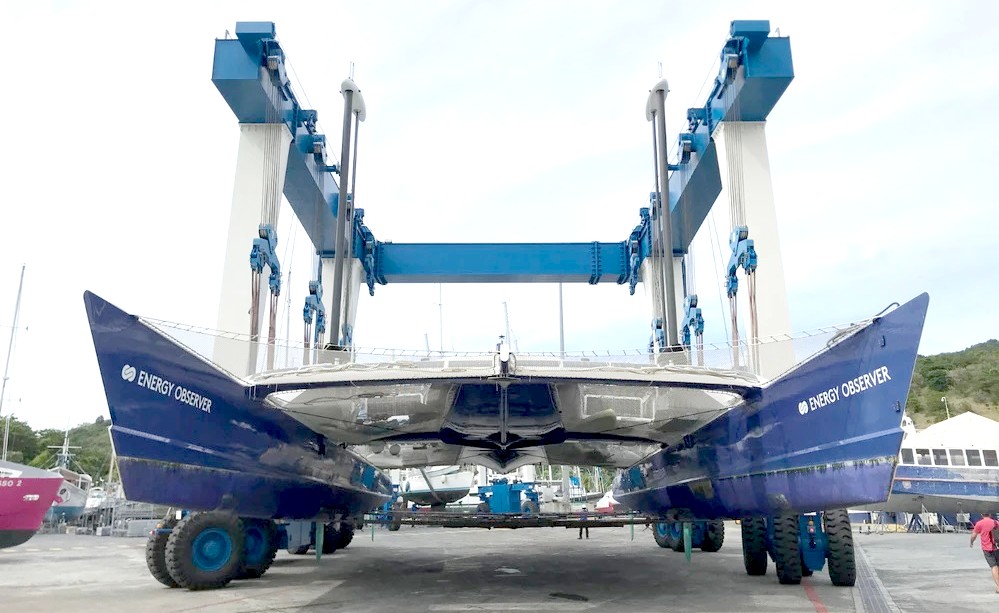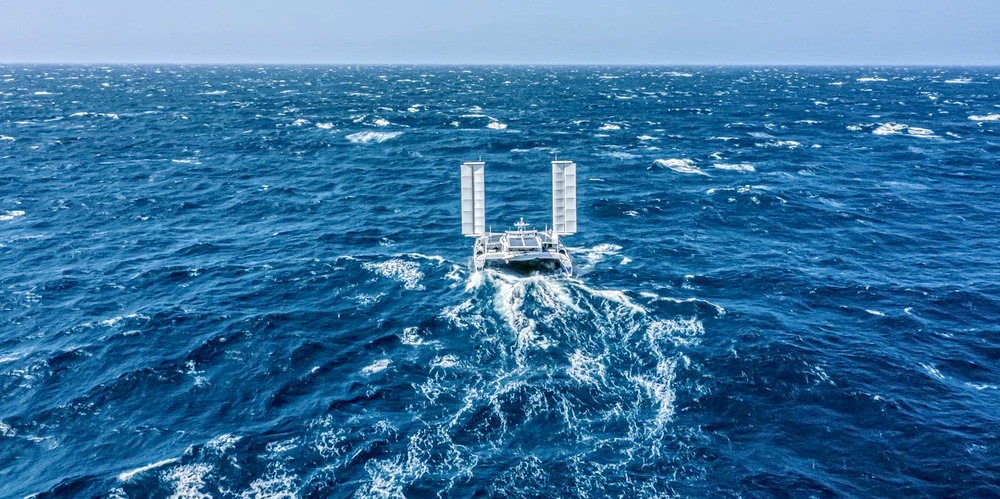|
ENERGY OBSERVER - HYDROPOWER
CLIMATE | CONTACTS | ELECTRICITY | FUEL CELLS | HYDROGEN | PLASTICS
Please use our SITE INDEX to navigate this site or return HOME
|
|
GREEN HYDROGEN - A hydrolyzer and fuel cell energy storage combination. In 2017, the first hydrogen-fueled "marine" fuel cell was installed in France on board Energy Observer, for a series of stopovers, in France, then in Europe, thus leading our autonomous ship to the Arctic Circle in 2019. During this trip, Energy Observer was equipped with a fuel cell, developing a power of 30kW, designed in collaboration with the CEA. Although it is still on board and has fulfilled its role wonderfully during these first couple of years, the energy needs of the ship kept increasing as new technologies were installed to be tested and as the navigation periods extended.
If the Energy Observer (EO) had been purpose designed and built, she would have been the largest solar powered vessel in the world. She was converted from a racing catamaran designed by Nigel Irens for sail powered yacht competitions. She has since been extended twice, but must be given recognition for her revised dimensions and the achievements of her team in several years of operation and development.
In 2020, the EO ship traveled nearly 11,000 nautical miles at an average speed of 4.4 knots. They admit it is still slow, but it's improving year after year.
FICTION - A version of the Energy Observer features in 'Kulo-Luna,' the story of a giant humpback whale that fights against whalers of a future world where ocean plastic has made fish so toxic, that whaling has become legal again to feed starving fishing nations.
SUN WIND HYDROPOWER
When
launched in April 2017, the Observer claims to be the first vessel in the world to both generate and be powered by hydrogen. She was developed in collaboration with engineers from the CEA-LITEN.
These specifications have since been changed along with lengthening of the hulls. Recently, 36.8m² of solar panel area have been added to the existing 165m² for 5.6Kw of additional power and a total surface area of 202m². As a result, the maximum power will be 34kWp (they have almost doubled the power since 2017) but the Observer does not have sun tracking as with the Elizabeth Swann, and the Swann has 55kW, with room for expansion. Much more harvesting area, but then the Swann was designed from the waves up to be solar powered. The Observer has a power to weight ratio of 1.14 kW/ton. More than PlanetSolar's 1.05kW/ton, but nowhere near the 3kW/ton potential of the Elizabeth Swann.
Energy Observer development continued in the winter of 2017 with a series of tests at sea before its big departure from Saint-Malo in the spring of 2018. It was scheduled to call in at Paris for a first event where the boat would be officially christened, with her new name. This event celebrated the start of a planned six-year expedition, scheduled from 2017 to 2022, visiting 50 countries and 101 ports of call including: historical ports, wildlife sanctuaries, natural reserves, endangered ecosystems, and international events. The Observer is a ZEWT, short for Zero Emission Waterborne Transport. The term ZEWT is typically applied to hydrogen vessels and other design improvements aimed at zero emission shipping.
Victorien Erussard, offshore racer and merchant naval officer, will lead the expedition, along with Jérôme Delafosse, professional diver and producer of wildlife documentaries. By their side, a team of over 30 people, architects, designers, and engineers, spreading from Saint-Malo to Paris to Grenoble, have been working since 2015 on refurbishing the catamaran.
Energy Observer is a former race boat that has been reconditioned: Built in Canada in 1983 by naval architect Nigel Irens, under the supervision of sailor Mike Birch. The 'maxi-multihull' marked the evolution of its successors. Baptised Formule TAG, presumably after the Swiss watch company, it was the first racing sailboat to break the symbolic 500 miles limit in 24 hours in 1984.
The boat has
been lengthened four times and now displays the following dimensions:
CONTACTS
Vincent Caumes
- Press Relations
Joséphine Guinard
- Press agent
For
questions related to the Odyssey: contact@energy-observer.org
https://www.energy-observer.org/
LATEST ADVANCES & UPGRADES
The transition from a 30kW battery to the new 80kW fuel cell (60kW continuous) has not only doubled the capacities of the vessel, it has increased them exponentially. Indeed, it is important to understand that a REXH2 is, like the
Toyota Mirai, designed to operate in conjunction with one or more batteries. Although it is theoretically possible to ensure the propulsion of a small boat, having a simple and recurrent user profile, with the electricity supplied by a single
fuel cell, it is more pragmatic to couple it with batteries which will serve both as an energy reserve (storage) and as an energy source for the propulsion and the hotel load.
In
their view, the REXH2, in electric hybridization, or even in diesel-hydrogen-electric hybridization, appears today as the option most likely to reduce as much as possible
CO2 and fine particle emissions on board ships, looking to the future improvement of green hydrogen production and storage capacities, when it may finally be possible to run fleets of ships on hydrogen to meet all of the on-board energy needs.
GREEN HYDROGEN - Electro-hydrogen hybridization is at the heart of the propulsion system of The New Era by HYNOVA Yachts, the first dayboat equipped with a REXH2® running on hydrogen and currently in approval phase. We spoke with Frédéric Ménière, President of EVE System, Chloé Zaied, Managing Director of HYNOVA Yachts, and Romain Jallon, Director of Operations at EODev, to explain how electro-hydrogen hybridization is ideal for decarbonized maritime mobility.
Where
the ocean is a roller coaster, not a
highway, a fuel cell is a sensitive organ, which must be protected from any external dust and harmful particles. In February 2020
the REXH2 was ready to be implemented for its first transatlantic crossing, but was unfortunately delayed a few times as a result of capricious weather conditions across the
Atlantic, something the Mayflower
came up against in 2021.
GREEN HYDROGEN - The REXH2® fuel cell - compressor – inverter set, installed back in 2019, boasts a maximum power output of 60 kW (though it is operated at around 50% of its potential to optimize its output).
HISTORY OF THE CRAFT
The slender bows of Formule TAG, now Energy Observer, remain the identifying feature of this famous ocean racer, but much else has changed during the boat’s many lives.
In 1993 it was bought by Peter Blake and Robin Knox-Johnston for a Jules Verne attempt, famously flying a spinnaker decorated with bright red and green apples under the name ENZA (Eat New Zealand Apples). The second attempt, in 1994, succeeded and the boat set a round the world crewed record of 74 days.
Tony Bullimore took it on, extending the hulls to 100ft and racing as Team Legato in the round the world race organised by Bruno Peyron to celebrate the year 2000: The Race.
|
|
|
PUSHING THE BOUNDARIES OF SCIENCE - The solar and wind powered 'Elizabeth Swann' will feature solar collectors and wind energy harvesting apparatus in an advanced configuration. She is seen here sporting a single VAWT electricity generator. Our mission is to mount a custom built vertical axis machine and test it, in relation to actual commercial routes. We also want to experiment with a hydrogen rig that is potentially more efficient than Observer's compressed gas system.
|
|
|
|
|
|
Please use our SITE INDEX to navigate this site or return HOME
This website is Copyright © 2021 Cleaner Ocean Foundation Ltd
|
